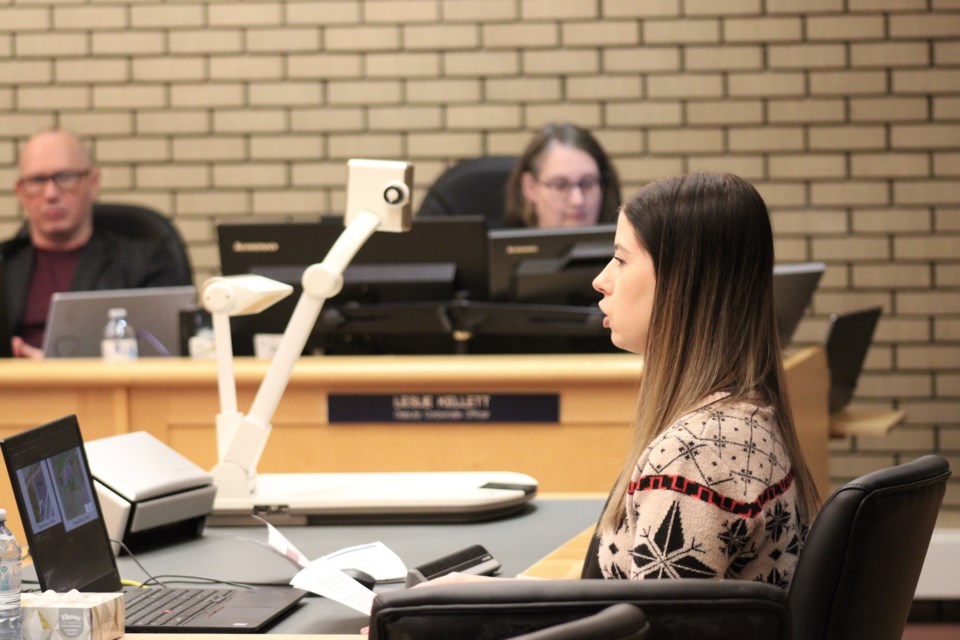A public hearing already cancelled twice finally went ahead at council's Monday, Feb. 3 council meeting, only for it to be closed abruptly after staff realized the proposed bylaw contained an error.
L&M Engineering is looking for zoning and official community plan changes on behalf of Eastway Sand & Gravel so that Tyrod Industrial can move to 880 Guay Rd., near the Prince George Regional Correctional Centre, and then expand its operations.
Those zoning changes would see a 22.7-hectare portion of the 48-hectare property rezoned from AG: Greenbelt and P6: Special Institutional to M2: General Industrial.
The firm also wants 3.3 hectares of the land rezoned from AF: Agriculture and Forestry and P6: Special Institution to AG: Greenbelt to create a buffer zone of trees to reduce noise made on site.
Under the OCP’s section on future land uses, different parts of the property are designated as rural resource as well as utility and light industrial. The amendment, if approved, would see the area designated as light industrial expand by 22.7 hectares.
The final council meeting of 2024 was supposed to host a public hearing on the proposed changes but was cancelled because the city was concerned that due to the then-ongoing postal strike, notices letting neighbours know about the hearing might not have arrived.
Then, the rescheduled hearing for the Jan. 13 council meeting was cancelled because city staff said the applicant did not update the signage on the property to reflect the new date.
It was issues with the proposed OCP amendments that led to the closure of the public hearing after L&M had already presented to council and nearby resident Sam Broadfoot had detailed her objections to the development.
L&M representative Megan Hickey said Tyrod Industrial started in 2006 as an owner-operated welding rig and has since expanded operations to include the fabrication and insultation of pressure piping systems, pressure vessels and structural steel.
The business needs to move to further expand its indoor operations, she said.
Her colleague, Terry Fjellstrom, said that because the proposed development is within 800 meters of Highway 16, the matter was referred to the BC Ministry of Transportation, who he said did not have any specific comments on the project.
A traffic summary letter written by L&M last summer measured peak traffic volumes near the property were and determined that they low enough not to require further study.
After the L&M presentation, Mayor Simon Yu pointed out that there was an overlap on a small portion of the property between an area proposed to have a restrictive covenant placed on it preventing construction and area designated in the OCP with a light industrial future land use.
Director of planning and development Deanna Wasnik agreed that there was an overlap and said she was trying to think of how all the documents could be reconciled. Since there were some strong oppositions to the development, Yu said it would be easier for council to figure out how to vote if the conflict was fixed.
Hickey made the case that when future land use maps are made, they’re not created with hard and fast boundaries.
“They’re more arbitrary,” she said. “I wouldn’t say they’re definitely following any definite land. I’d have to direct this to administration, but I believe the covenant would trump everything.”
The mayor responded, saying that even if the zoning was massaged a bit, there would be no public hearing required. That means that if the applicant wanted to remove the covenants later, only council would weigh in on the decision.
“I just want to correct this right now if it’s just a clarification, so we don’t have to deal with this in the future,” Yu said.
Manager of legislative services Ethan Anderson said Yu’s interpretation was incorrect and there would have to be a public hearing should the covenant be removed.
Then it was time for public comments, where Broadfoot outlined a long list of concerns with the proposed development.
“This is an issue that could severely impact the safety, the environment and the quality of life for the residential properties on Guay Road,” Broadfoot said.
She said the road infrastructure is inadequate for the trucks and heavy machinery that will be used on the property, calling it a “disaster waiting to happen” and criticizing the maintenance of the road.
Power lines along the road hang too low, Broadfoot said, posing a danger to tall loads on passing trucks.
Potential noise pollution, dust that will be kicked up by the activity on the site and light pollution will decrease quality of life for nearby residents, she said.
She said nearby residents were willing to accept rezoning only under certain conditions — decommissioning existing access roads and creating a new one, reclamation of the old site with noise-reducing measures and strict enforcement of nuisance bylaws at the site.
As Yu responded to Broadfoot’s remarks, Anderson interrupted to request a short recess, which the mayor granted.
Anderson and Yu then went into a side room while Wasnik brought the L&M representatives into the lobby in front of council chambers for a discussion.
When proceedings reconvened, Anderson said it was clear after Yu’s earlier comments that the bylaw tried to rezone a portion of the property contrary to the use laid out in the OCP.
“We need to amend the bylaw but unfortunately, under the legislation, you can’t amend the bylaw after the public hearing has been closed,” Anderson said. “Therefore, we’re asking that the public hearing be closed, we amend the bylaw and then we hold another public hearing to deal with that.”
As a result, councillors voted to close the session and host another hearing at their Feb. 24 meeting.
Notification of the new public hearing will go out to neighbouring property owners, who will have another chance to air their opinions on the development.



